
[NOTE: This is an update to a piece I first published in the depths of the bitcoin bear market in Q4 2018.]
“I think it’s essential to remember that just about everything is cyclical. There’s little I’m certain of, but these things are true: Cycles always prevail eventually. Nothing goes in one direction forever. Trees don’t grow to the sky. Few things go to zero. And there’s little that’s as dangerous for investor health as insistence on extrapolating today’s events into the future.”
- Howard Marks, billionaire investor
With Bitcoin in the midst of another breathtaking bull market, we wanted to take a step back and examine the cryptocurrency’s full cycles (from bear market trough to the next bear market trough) over its history to see what insights we can draw from the bitcoin price history to help navigate the current cycle.
2010 – November 2011: Bitcoin’s first bull/bear cycle
For most of bitcoin’s first year, it was merely a niche experiment for a dedicated group of developers called “cypherpunks.” The nascent cryptocurrency’s first expansion beyond this tightknit group was kickstarted by the establishment of Mt. Gox, the first major bitcoin exchange, in July 2010. From that point until the exchange was hacked in June 2011, bitcoin’s price rocketed from $0.06 to a peak of $29.38, a nearly 50,000% rally in less than a year!
As even casual followers of the market have discovered by now though, cryptoassets oscillate between periods of excessive euphoria and deep depression; bitcoin’s first big bubble provided the quintessential example of this phenomenon. With nowhere to easily exchange their newly acquired assets and fears about the legitimacy of the whole enterprise, investors sold bitcoin en masse, driving the price down to a low of just $2.14 by November, a full -93% decline in less than half a year. At the trough of peak despondency, even the most diehard believers were no doubt second-guessing their commitment to cryptocurrencies.
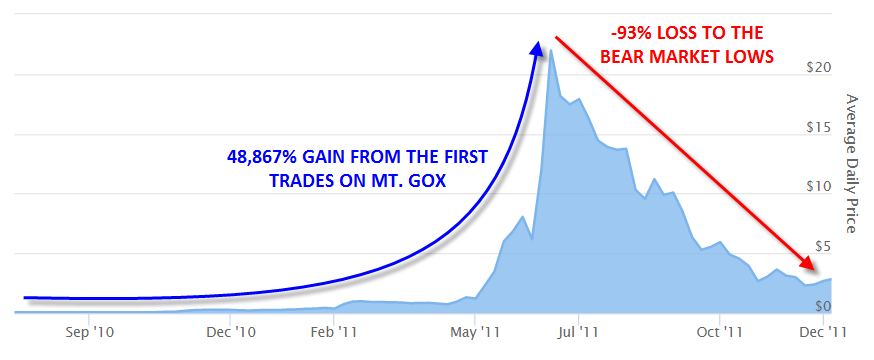
Source: 99Bitcoins, StoneX
November 2011 – July 2013: Cyprus sparks another run in Bitcoin
The night is darkest just before the dawn, as they say, and bitcoin embarked on another bull cycle starting in late 2011. While there were several brief 20-30% declines along the way, bitcoin bulls remained generally in control throughout 2012 and into early 2013 as the cryptocurrency’s supranational status appealed to investors throughout Cyprus’s ongoing financial crisis (to say nothing of the cryptocurrency’s newfound utility in illicit transactions).
Bitcoin eventually peaked at $212.38 in April 2013 amidst (what else?) issues with the newly-revived Mt. Gox exchange, this time centered around the site’s stability and regulatory concerns. From there, prices fell nearly 70% over the next week alone to trade below $66, and after bouncing through the rest of Q2, revisited that low again in early July.
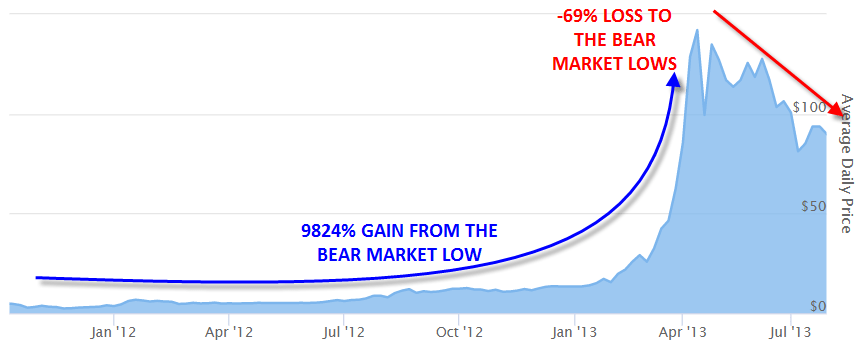
Source: 99Bitcoins, StoneX
July 2013 – January 2015: China enters the bitcoin fray
In late 2013, the center of the bitcoin trading world migrated from Tokyo (where Mt. Gox was based) across the Sea of Japan to China, the planet’s most populous country. Amidst a booming economy and relatively strict capital controls, Chinese traders took immediately to speculating on bitcoin, bolstered by an endorsement from the People’s Bank of China in November 2013. However, in what’s since become a common theme for cryptoassets, China seemingly reneged on its support a few weeks later, banning financial institutions from using bitcoin in early December. The Chinese government went on to issue additional strict regulations on the market in the coming months, putting an end to bitcoin’s third major cycle.
Bitcoin rode the regulatory tide from a trough of $68 in July 2013 to peak above $1200 by late November. From there, the cryptocurrency endured its longest (though not deepest) bearish cycle; prices eventually bottomed out below $200 in January 2015, losing a full -84% over more than a year.
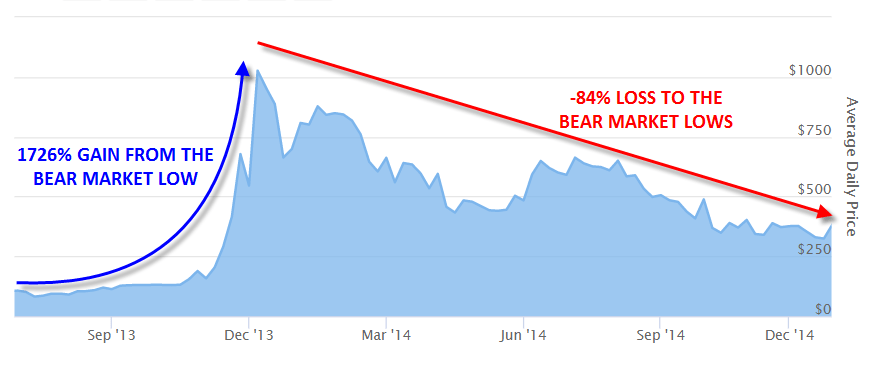
Source: 99Bitcoins, StoneX
January 2015 – December 2018: Bitcoin goes mainstream
Befitting the recovery from its longest bear market, bitcoin began its longest bull run in January 2015, though few investors knew it at the time. Prices gradually began to grind higher as new exchanges cropped up and an increasing number of vendors started to accept bitcoin for payments. Climbing the proverbial “wall of worry,” the cryptocurrency was able to shrug off continued exchange hacks, a “halving” of the reward for mining a bitcoin block, and multiple forks on its way to peak near $20,000 the week before Christmas 2017.
The market eventually bottomed a year later with little fanfare as a public that was inundated with stories of Bitcoin millionaires wrote off the asset as a temporary fad like beanie babies or Dutch tulips.
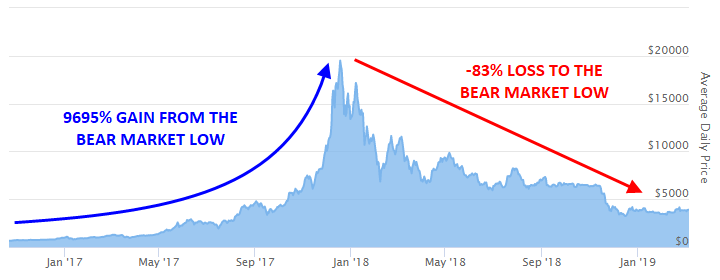
Source: 99Bitcoins, StoneX
December 2018 - ???: Bitcoin breaks $1T in market cap as Wall Street arrives late to the party
In a similar trend to previous cycles, Bitcoin has since risen from the proverbial ashes to set fresh record highs over the last couple years. From a fundamental perspective, the biggest catalyst in this bullish cycle has been institutional adoption, with brokerages (stretching from traditional shops like Fidelity to upstart millennial-focused competitors like Robinhood), corporations (including 170-year old insurance companies like MassMutual to EV manufacturers like Tesla), and even central banks exploring opportunities to invest in cryptocurrencies.
Around the time of the Coinbase IPO earlier this month, Bitcoin hit a fresh record high above $63,500, up 1,864% from bear market trough so far:
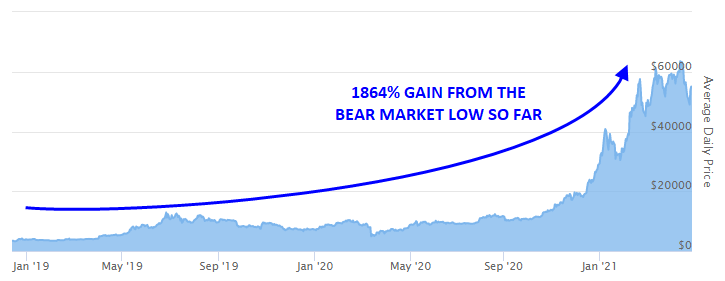
Source: 99Bitcoins, StoneX
Conclusions: The future of Bitcoin
As the table of bitcoin price history below shows, the current bull market in Bitcoin has lasted longer than the average bull market to date, but the percentage gain off the lows is nowhere near the historical bull market average, nor is the peak price multiple relative the previous bull market peak:
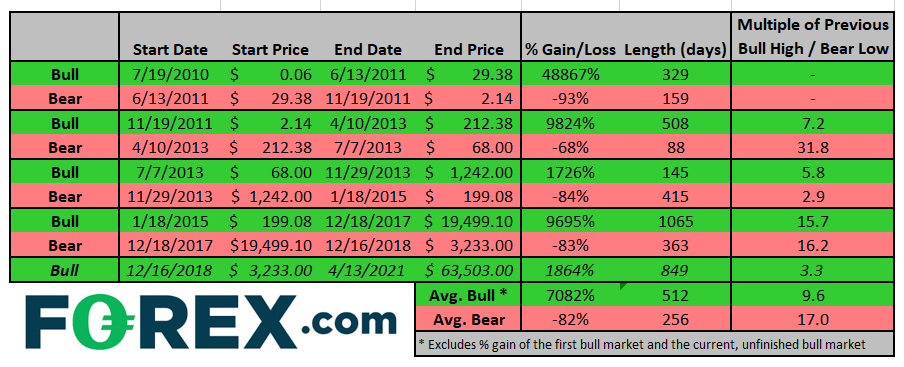
Source: StoneX
Of course, as the asset class matures, it’s reasonable to expect the magnitude of its price cycles to fall and the duration to extend, but if we see prices enter a prolonged bear market from here, it would mark arguably the least impressive bull market bitcoin has ever seen. With institutional adoption still on the rise and retail euphoria nowhere near the levels we saw back in Q4 2017, the future of bitcoin remains bright for a continuation of this bull market cycle.
Learn more about cryptoasset trading opportunities.


